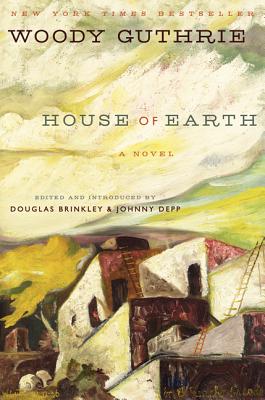Finished in 1947 and lost to readers until now, House of Earth is Woody Guthrie's only fully realized novel—a powerful portrait of Dust Bowl America, filled with the homespun lyricism and authenticity that have made his songs a part of our national consciousness. It is the story of an ordinary couple's dreams of a better life and their search for love and meaning in a corrupt world.
Tike and Ella May Hamlin struggle to plant roots in the arid land of the Texas Panhandle. The husband and wife live in a precarious wooden farm shack, but Tike yearns for a sturdy house that will protect them from the treacherous elements. Thanks to a five-cent government pamphlet, Tike has the know-how to build a simple adobe dwelling, a structure made from the land itself—fireproof, windproof, Dust Bowl–proof. A house of earth.
Though they are one with the farm and with each other, the land on which Tike and Ella May live and work is not theirs. Due to larger forces beyond their control—including ranching conglomerates and banks—their adobe house remains painfully out of reach.
A story of rural realism and progressive activism, and in many ways a companion piece to Guthrie's folk anthem "This Land Is Your Land," House of Earth is a searing portrait of hardship and hope set against a ravaged landscape. Combining the moral urgency and narrative drive of John Steinbeck with the erotic frankness of D. H. Lawrence, here is a powerful tale of America from one of our greatest artists.
Take a peek at it HERE.
Jackie says:
"I've spent the last couple of days lost in the 1930s Dust Bowl, specifically on the Texas plains. It's a hard, nasty place to be, but it was enlivened by the passionate Tike and Ella May Hamlin--wheat farmers and plain and simple, but they've got big dreams. They live in a rotting share-croppers shack, but five cents bought them a government pamphlet giving directions to create adobe bricks which would be safe from the horrible winds of the plains, protect them from the heat and the cold, and would not be prone in insect infestation. A place to grow their family in. If they can find land to build on.
There is a whole lot of societal, financial and political talk in here, told with a lot of passion, frustration, and hope. It's the same, or very nearly so, that you'll find any time you turn on the news these days. This is the only book Guthrie finished, but he's made it count. He lived through the "Black Sunday: (4-14-1935) dust storm in Pampa, TX. When the storm ended, he was a changed man. He's the one who bought that five cent pamphlet and crusaded for adobe housing for the rest of his life. The lengthy introduction, written by Doug Brinkley and Johnny Depp (yes, THE Johnny Depp), covers a lot of that and Guthrie's life from then on. That alone is fascinating, but combined with the novel, the whole package adds up to a big bite of the history and culture that shaped America. Sometimes funny, sometimes bawdy, sometimes heartbreaking, this book is a gem that will make a big impression on any reader. Just because it was written in 1945 doesn't mean it can't be the best book of 2013, at least in my humble opinion."


No comments:
Post a Comment